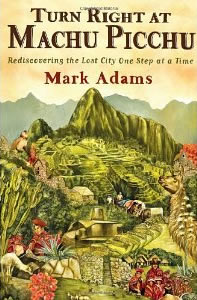Book Notes
 Mark Adams, Turn Right at Machu Picchu; Rediscovering the Lost City One Step at a Time (New York: Dutton, 2011), 333pp.
Mark Adams, Turn Right at Machu Picchu; Rediscovering the Lost City One Step at a Time (New York: Dutton, 2011), 333pp.
Every year thousands of people trek to the remote Incan remains of Machu Picchu in Peru, and every year the same confounding questions tantalize them when they behold the breathtaking beauty. How and why did the Incans build these two hundred 15th-century structures cut into the terraced hills 8,000 feet high in the Peruvian Andes? The Incas only ruled for about a century before the Spanish conquered them in 1572, but their architectural legacy remains one of the world's wonders. The site gets 76 inches of rain a year, but boasts extensive drains, canals, and fountains. No mortar, wheel, or iron tools were used with the precision-fitted granite rock. No written language or carvings remain to explain the sacred site.
Mark Adams writes for adventure travel magazines, although he's the first to admit that his outdoor skills are, shall we say, minimal. His book was published to coincide with the hundredth anniversary of the 1911 "discovery" of Machu Picchu by Hiram Bingham III. He combines self-effacing humor and serious cultural history to retrace Bingham's three expeditions and subsequent controversial claims, lawsuits, and reputation. Was Bingham a villain, a hero, or a fraud? He tries to untangle Incan fact and fiction. He situates Machu Picchu into the larger complex of nearby sites, like Espiritu Pampa with its 700 buildings. He treks from the humid Amazon jungles to the lofty Andes mountains.
Most of these Incan sites remain unexplored even today, partly because (by design) they are nearly inaccessible, partly because the dense jungles overtake them in a matter of months, partly because the Spanish destroyed so much, and also because of contemporary looters. By one estimate only about 25% of these remains have been excavated. And so the intrigue and allure of adventure archaeology remains as strong as ever. Indiana Jones, whose character was at least partly based upon Bingham's story, was popular for good reason. At best we're left with educated guesses about Machu Picchu. "The truth is," writes Adams at the end of his book, "that Machu Picchu is always going to be something of a mystery" (287).


